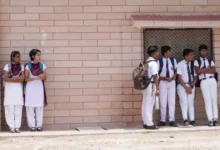In the beloved Kannada drama “Sadarame,” veteran performer Jayashree carries on her grandfather’s tradition
Stage figures seldom get the same kind of ardent devotion often bestowed upon movie stars. But Kalla, a pivotal role in the cult classic Kannada drama Sadarame, succeeds in doing just that. Today’s performance at Ranga Shankara, JP Nagar features renowned dramatist, actress, and playback singer B Jayashree, who is also the director, reprising the part that was first played by Gubbi Veranna, a pioneer of Kannada theater and film.

“This company play, Sadarame, was very well-liked. This play was brought back whenever the corporation was having trouble making money, and it was always a big hit. People may relate to the play’s narrative since it is universal. Thus, even though it was first performed many years before I was even born, it still has a lot of relevance today, Jayashree says, adding that she chose to bring the play back in the early 2010s at the suggestion of her fellow performer Arundathi Nag.
“I received a call from Aru [Arundathi Nag] asking me to participate in a play from the Gubbi company for her firm’s theater festival. We deliberated over other choices, such as Dashavathara and Akka Mahadevi. Nevertheless, a number of issues, such as casting and expense, kept us from giving such concepts more thought. Aru recommended that I perform sadarame in its place. However, it presented another issue: how would I locate a Kalla to take Gubbi Veeranna’s place? “Why don’t you do it yourself?” Aru said, she continues.
The 73-year-old did not make the choice to assume the position of Kalla lightly. She was under a lot of pressure to uphold her grandfather’s heritage and to do it with honor, no matter how imperfect. “I’m happy to report that people first recognize me as Veeranna’s granddaughter and then for my work.” I didn’t want to play a part that my grandpa had played and ruin his legacy if I didn’t do it well,” she says.
She wasn’t persuaded despite Nag’s perseverance and the emotional backing of friends and family, especially Jayashree’s mother GV Malathamma. However, I was contacted by a friend who advised me not to make such a mistake. Don’t attempt to ruin Veeranna’s reputation; something has evolved. I became enraged and asked myself, “How can I ruin this play when I’ve been in the theater for so long?” I saw it as a challenge, yet fear still consumed me,” Jayashree explains.
However, all of her worries were allayed when she eventually took the stage for the first time as Kalla and was warmly welcomed by the crowd. It was a tremendous achievement for me to portray a part as a woman beside Gubbi Veeranna. It was harder to face the crowd than it was to play the job perfectly. It was amazing the first time I performed live; it was something I had never done before in my career. The way I was embraced by the crowd, first with hesitation and then without reservation… My mother shares with me that she had the impression that she was seeing her father perform.
Jayashree, however, had no written script to follow because of the Gubbi company’s oral heritage. “My mother, Paramashivanna, and Dingri Nagaraj joined me at the table. We rebuilt the script as the three would recount the play from memory as I jotted it down. There were around 500 songs in the original show!
We revised the script to reduce the amount of songs to 10 to 15 and to cut the performance time down to around two hours since we couldn’t possibly attempt to execute it at that scale,” she says.
The piece also takes the audience on a nostalgic trip through the golden era of company theater. We have made sure that the stage design, clothing, and other details are all as true to the original as possible. As a result, the backdrop is undulating and features lovely scenery. With these backdrops, you could position them in a Russian road if you wanted one for a scenario! One may ask, why is it necessary? The allure of this, however, is that the possibilities for creativity were endless. Similarly, even in roles when they were husband and wife, performers would not come into contact with one another on stage. Thus, it’s like to taking a walk down memory lane, illustrating the past of company theater,” continues Jayashree.







